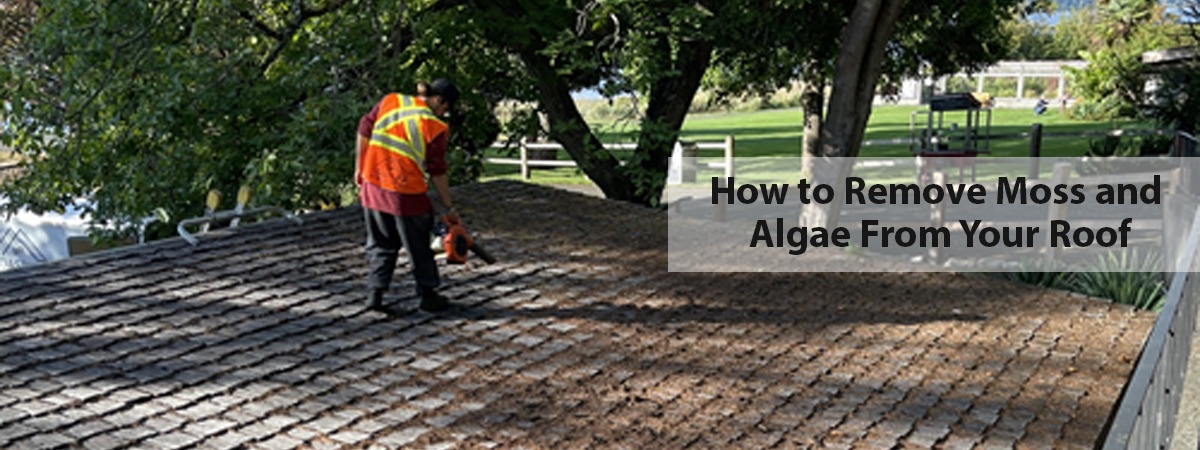
The green grass-like layer accumulated on your roof can be more harmful than you think. In fact, if left untreated, it will further damage and weaken your roof exterior and eventually leak into your home’s foundation. Long-time deposits of moss and algae can result in serious damage to the roof along with consequential health problems to your families such as asthma and severe headaches. It becomes crucial to remove moss and algae from your roof.
Your roof (either made up of asphalt shingles, wood or tiles) can easily catch stains and streaks during warm and humid summers. These stains and streaks could be both- algae (actually blue-green algae) or moss. Before you rush to search for roof cleaning near me in Vancouver. It is important you first understand how moss and algae work.
Introduction to Moss and Algae Removal from Roof
Algae is a photosynthetic group of organisms with no roots, leaves, and stems, whereas moss is a small green plant with no flowers and original roots. It is a single-celled plant grown in a cluster whereas moss is a thread-like structure called fibrous or feathered. It proliferates in wet places, on the other hand, mosses are found in damp places. Algae is a marine plant whereas mosses are mostly terrestrial.
How Algae and Moss can ruin your roof?
Algae and moss spread fast in shady and humid climates where there is less UV exposure. Making north-facing houses prone to roof decay. The dark streaks you see on your roofs, especially roofs with asphalt shingles, are algae. Wondering why it develops on your roof in the first place? We know that algae can easily spread from one place to another. The algae spores get accumulated on your roof through winds, birds, or varmints. Once they get settled, they will crowd out the roof, grow persistently, and put your roof to slow decaying.
Moss spores also make their way through the winds, birds, or animals as algae spores do. They easily develop themselves under shady and damp environments. If they keep developing themselves, they will soon become a thick and mat-like layer. The decay rate, however, depends upon what your roof is made of – asphalt shingles, wood shingles, or tiles. The woods have a higher decay rate than asphalt or tile shingles as they have an uneven surface, making mosses grow even better.
Unlike other plants, moss has a unique function of transporting water through its leaves. Therefore, it soaks up all the moisture present outside making roofs retain excessive water. These factors lead to your roofs getting weaker and rotting over time.
Highly Effective Algae and Moss Removal Methods
One of the most efficient methods for algae and moss removal could be replacing your entire roof with a new one. This costly method will give a permanent fix but will likely hurt your finances. There are other less expensive yet time-saving solutions you can opt for. Either you can DIY or hire a professional to get rid of algae and moss. Though, hiring a professional is highly recommended to preserve the quality of roof material and for your own safety while cleaning the roof. The correct way that most moss removal professionals use is soft wash roof cleaning in Vancouver to increase the longevity of the roof.
Note: Pressure wash exposes your rooftop for premature failing as it takes off rooftop granules along with the algae and the moss.
Hiring a professional saves both – time and effort. However, if you are thinking of removing algae and moss all by yourself, here’s what you need to know:
You can use bleach spray for roof washing in Vancouver. This bleach spray is a 1:1 mixture of bleach and water. Give your spray a good mix and spray it over the affected areas. Let it dry for half an hour. Now, rinse it with clean water.
Note: Thick mosses won’t go over a single spray. To completely remove algae and moss from your roof, you might need to spray twice or thrice a month.
Best practices to keep moss and algae from coming back
- Insert 6-inch wide zinc or copper strips under your asphalt shingles to prevent algae and moss from spreading.
- Timely pruning of limbs aids in proper sun exposure which is necessary to cease algae and moss growth.
- Regular roof washing can help prevent the accumulation of algae and moss.
- Proper water drainage helps in drying up gutters, as damp gutters encourage algae and moss growth.
- There are certain moss killer chemicals available in the market that help you fix algae and moss problems.
If you are unable to remove moss / algae safely yourself, please contact a professional near you who is able to remove it and prevent further damage to your home.